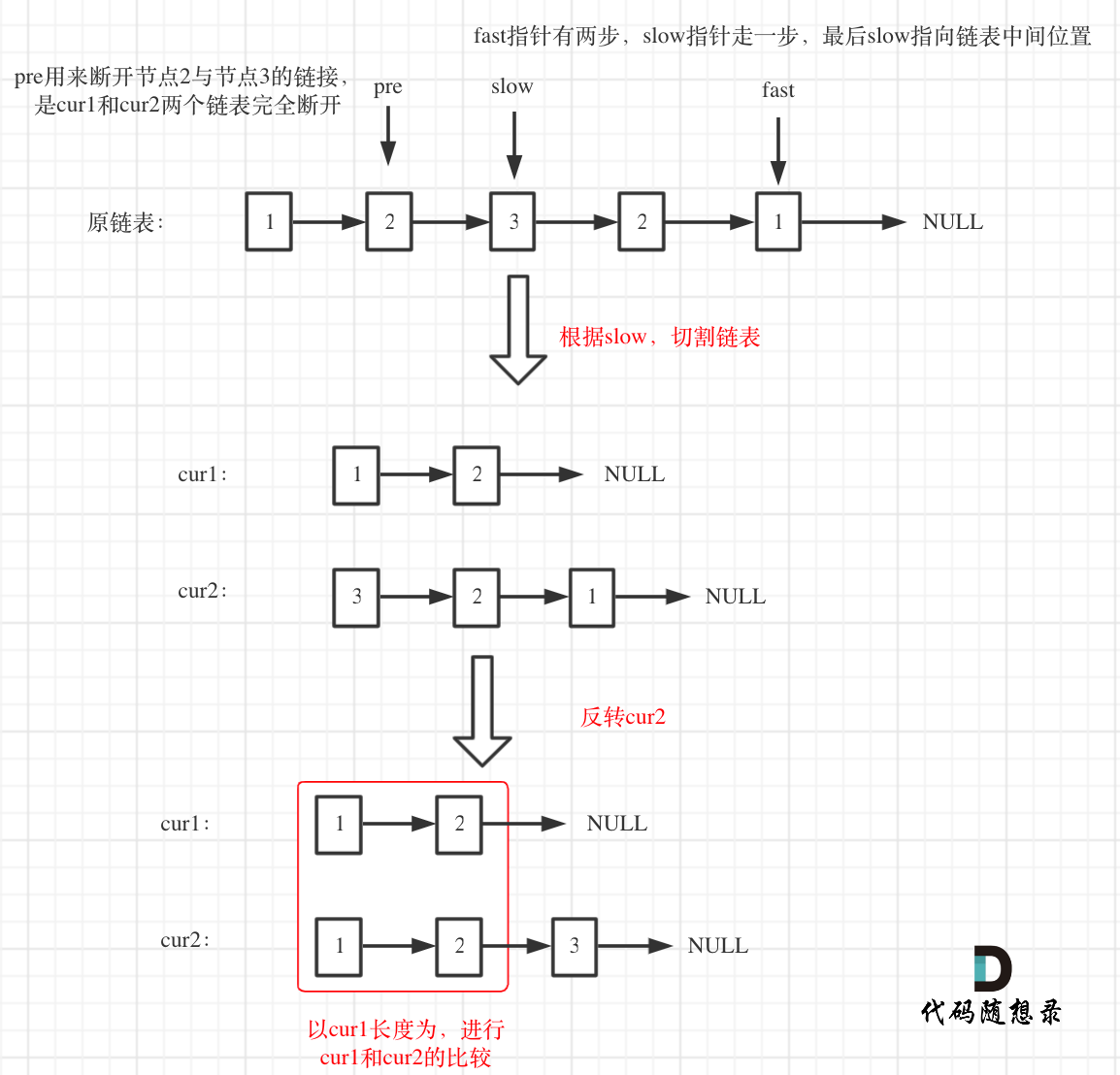- 做项目(多个C++、Java、Go、测开、前端项目) (opens new window)
- 刷算法(两个月高强度学算法) (opens new window)
- 背八股(40天挑战高频面试题) (opens new window)
# 234.回文链表
请判断一个链表是否为回文链表。
示例 1:
- 输入: 1->2
- 输出: false
示例 2:
- 输入: 1->2->2->1
- 输出: true
# 思路
# 数组模拟
最直接的想法,就是把链表装成数组,然后再判断是否回文。
代码也比较简单。如下:
class Solution {
public:
bool isPalindrome(ListNode* head) {
vector<int> vec;
ListNode* cur = head;
while (cur) {
vec.push_back(cur->val);
cur = cur->next;
}
// 比较数组回文
for (int i = 0, j = vec.size() - 1; i < j; i++, j--) {
if (vec[i] != vec[j]) return false;
}
return true;
}
};
1
2
3
4
5
6
7
8
9
10
11
12
13
14
15
16
2
3
4
5
6
7
8
9
10
11
12
13
14
15
16
上面代码可以在优化,就是先求出链表长度,然后给定vector的初始长度,这样避免vector每次添加节点重新开辟空间
class Solution {
public:
bool isPalindrome(ListNode* head) {
ListNode* cur = head;
int length = 0;
while (cur) {
length++;
cur = cur->next;
}
vector<int> vec(length, 0); // 给定vector的初始长度,这样避免vector每次添加节点重新开辟空间
cur = head;
int index = 0;
while (cur) {
vec[index++] = cur->val;
cur = cur->next;
}
// 比较数组回文
for (int i = 0, j = vec.size() - 1; i < j; i++, j--) {
if (vec[i] != vec[j]) return false;
}
return true;
}
};
1
2
3
4
5
6
7
8
9
10
11
12
13
14
15
16
17
18
19
20
21
22
23
24
25
2
3
4
5
6
7
8
9
10
11
12
13
14
15
16
17
18
19
20
21
22
23
24
25
# 反转后半部分链表
分为如下几步:
- 用快慢指针,快指针有两步,慢指针走一步,快指针遇到终止位置时,慢指针就在链表中间位置
- 同时用pre记录慢指针指向节点的前一个节点,用来分割链表
- 将链表分为前后均等两部分,如果链表长度是奇数,那么后半部分多一个节点
- 将后半部分反转 ,得cur2,前半部分为cur1
- 按照cur1的长度,一次比较cur1和cur2的节点数值
如图所示:

代码如下:
class Solution {
public:
bool isPalindrome(ListNode* head) {
if (head == nullptr || head->next == nullptr) return true;
ListNode* slow = head; // 慢指针,找到链表中间分位置,作为分割
ListNode* fast = head;
ListNode* pre = head; // 记录慢指针的前一个节点,用来分割链表
while (fast && fast->next) {
pre = slow;
slow = slow->next;
fast = fast->next->next;
}
pre->next = nullptr; // 分割链表
ListNode* cur1 = head; // 前半部分
ListNode* cur2 = reverseList(slow); // 反转后半部分,总链表长度如果是奇数,cur2比cur1多一个节点
// 开始两个链表的比较
while (cur1) {
if (cur1->val != cur2->val) return false;
cur1 = cur1->next;
cur2 = cur2->next;
}
return true;
}
// 反转链表
ListNode* reverseList(ListNode* head) {
ListNode* temp; // 保存cur的下一个节点
ListNode* cur = head;
ListNode* pre = nullptr;
while(cur) {
temp = cur->next; // 保存一下 cur的下一个节点,因为接下来要改变cur->next
cur->next = pre; // 翻转操作
// 更新pre 和 cur指针
pre = cur;
cur = temp;
}
return pre;
}
};
1
2
3
4
5
6
7
8
9
10
11
12
13
14
15
16
17
18
19
20
21
22
23
24
25
26
27
28
29
30
31
32
33
34
35
36
37
38
39
40
2
3
4
5
6
7
8
9
10
11
12
13
14
15
16
17
18
19
20
21
22
23
24
25
26
27
28
29
30
31
32
33
34
35
36
37
38
39
40
# 其他语言版本
# Java
// 方法一,使用数组
class Solution {
public boolean isPalindrome(ListNode head) {
int len = 0;
// 统计链表长度
ListNode cur = head;
while (cur != null) {
len++;
cur = cur.next;
}
cur = head;
int[] res = new int[len];
// 将元素加到数组之中
for (int i = 0; i < res.length; i++){
res[i] = cur.val;
cur = cur.next;
}
// 比较回文
for (int i = 0, j = len - 1; i < j; i++, j--){
if (res[i] != res[j]){
return false;
}
}
return true;
}
}
// 方法二,快慢指针
class Solution {
public boolean isPalindrome(ListNode head) {
// 如果为空或者仅有一个节点,返回true
if (head == null && head.next == null) return true;
ListNode slow = head;
ListNode fast = head;
ListNode pre = head;
while (fast != null && fast.next != null){
pre = slow; // 记录slow的前一个结点
slow = slow.next;
fast = fast.next.next;
}
pre.next = null; // 分割两个链表
// 前半部分
ListNode cur1 = head;
// 后半部分。这里使用了反转链表
ListNode cur2 = reverseList(slow);
while (cur1 != null){
if (cur1.val != cur2.val) return false;
// 注意要移动两个结点
cur1 = cur1.next;
cur2 = cur2.next;
}
return true;
}
ListNode reverseList(ListNode head){
// 反转链表
ListNode tmp = null;
ListNode pre = null;
while (head != null){
tmp = head.next;
head.next = pre;
pre = head;
head = tmp;
}
return pre;
}
}
1
2
3
4
5
6
7
8
9
10
11
12
13
14
15
16
17
18
19
20
21
22
23
24
25
26
27
28
29
30
31
32
33
34
35
36
37
38
39
40
41
42
43
44
45
46
47
48
49
50
51
52
53
54
55
56
57
58
59
60
61
62
63
64
65
66
67
68
69
2
3
4
5
6
7
8
9
10
11
12
13
14
15
16
17
18
19
20
21
22
23
24
25
26
27
28
29
30
31
32
33
34
35
36
37
38
39
40
41
42
43
44
45
46
47
48
49
50
51
52
53
54
55
56
57
58
59
60
61
62
63
64
65
66
67
68
69
# Python
#数组模拟
class Solution:
def isPalindrome(self, head: Optional[ListNode]) -> bool:
list=[]
while head:
list.append(head.val)
head=head.next
l,r=0, len(list)-1
while l<=r:
if list[l]!=list[r]:
return False
l+=1
r-=1
return True
#反转后半部分链表
class Solution:
def isPalindrome(self, head: Optional[ListNode]) -> bool:
fast = slow = head
# find mid point which including (first) mid point into the first half linked list
while fast and fast.next:
fast = fast.next.next
slow = slow.next
node = None
# reverse second half linked list
while slow:
slow.next, slow, node = node, slow.next, slow
# compare reversed and original half; must maintain reversed linked list is shorter than 1st half
while node:
if node.val != head.val:
return False
node = node.next
head = head.next
return True
1
2
3
4
5
6
7
8
9
10
11
12
13
14
15
16
17
18
19
20
21
22
23
24
25
26
27
28
29
30
31
32
33
34
35
36
37
2
3
4
5
6
7
8
9
10
11
12
13
14
15
16
17
18
19
20
21
22
23
24
25
26
27
28
29
30
31
32
33
34
35
36
37
# Go
/**
* Definition for singly-linked list.
* type ListNode struct {
* Val int
* Next *ListNode
* }
*/
//方法一,使用数组
func isPalindrome(head *ListNode) bool{
//计算切片长度,避免切片频繁扩容
cur,ln:=head,0
for cur!=nil{
ln++
cur=cur.Next
}
nums:=make([]int,ln)
index:=0
for head!=nil{
nums[index]=head.Val
index++
head=head.Next
}
//比较回文切片
for i,j:=0,ln-1;i<=j;i,j=i+1,j-1{
if nums[i]!=nums[j]{return false}
}
return true
}
// 方法二,快慢指针
func isPalindrome(head *ListNode) bool {
if head==nil&&head.Next==nil{return true}
//慢指针,找到链表中间分位置,作为分割
slow:=head
fast:=head
//记录慢指针的前一个节点,用来分割链表
pre:=head
for fast!=nil && fast.Next!=nil{
pre=slow
slow=slow.Next
fast=fast.Next.Next
}
//分割链表
pre.Next=nil
//前半部分
cur1:=head
//反转后半部分,总链表长度如果是奇数,cur2比cur1多一个节点
cur2:=ReverseList(slow)
//开始两个链表的比较
for cur1!=nil{
if cur1.Val!=cur2.Val{return false}
cur1=cur1.Next
cur2=cur2.Next
}
return true
}
//反转链表
func ReverseList(head *ListNode) *ListNode{
var pre *ListNode
cur:=head
for cur!=nil{
tmp:=cur.Next
cur.Next=pre
pre=cur
cur=tmp
}
return pre
}
1
2
3
4
5
6
7
8
9
10
11
12
13
14
15
16
17
18
19
20
21
22
23
24
25
26
27
28
29
30
31
32
33
34
35
36
37
38
39
40
41
42
43
44
45
46
47
48
49
50
51
52
53
54
55
56
57
58
59
60
61
62
63
64
65
66
67
68
69
2
3
4
5
6
7
8
9
10
11
12
13
14
15
16
17
18
19
20
21
22
23
24
25
26
27
28
29
30
31
32
33
34
35
36
37
38
39
40
41
42
43
44
45
46
47
48
49
50
51
52
53
54
55
56
57
58
59
60
61
62
63
64
65
66
67
68
69
# JavaScript
var isPalindrome = function(head) {
const reverseList = head => {// 反转链表
let temp = null;
let pre = null;
while(head != null){
temp = head.next;
head.next = pre;
pre = head;
head = temp;
}
return pre;
}
// 如果为空或者仅有一个节点,返回true
if(!head && !head.next) return true;
let slow = head;
let fast = head;
let pre = head;
while(fast != null && fast.next != null){
pre = slow; // 记录slow的前一个结点
slow = slow.next;
fast = fast.next.next;
}
pre.next = null; // 分割两个链表
// 前半部分
let cur1 = head;
// 后半部分。这里使用了反转链表
let cur2 = reverseList(slow);
while(cur1 != null){
if(cur1.val != cur2.val) return false;
// 注意要移动两个结点
cur1 = cur1.next;
cur2 = cur2.next;
}
return true;
};
1
2
3
4
5
6
7
8
9
10
11
12
13
14
15
16
17
18
19
20
21
22
23
24
25
26
27
28
29
30
31
32
33
34
35
2
3
4
5
6
7
8
9
10
11
12
13
14
15
16
17
18
19
20
21
22
23
24
25
26
27
28
29
30
31
32
33
34
35
# TypeScript
数组模拟
function isPalindrome(head: ListNode | null): boolean {
const helperArr: number[] = [];
let curNode: ListNode | null = head;
while (curNode !== null) {
helperArr.push(curNode.val);
curNode = curNode.next;
}
let left: number = 0,
right: number = helperArr.length - 1;
while (left < right) {
if (helperArr[left++] !== helperArr[right--]) return false;
}
return true;
};
1
2
3
4
5
6
7
8
9
10
11
12
13
14
2
3
4
5
6
7
8
9
10
11
12
13
14
反转后半部分链表
function isPalindrome(head: ListNode | null): boolean {
if (head === null || head.next === null) return true;
let fastNode: ListNode | null = head,
slowNode: ListNode = head,
preNode: ListNode = head;
while (fastNode !== null && fastNode.next !== null) {
preNode = slowNode;
slowNode = slowNode.next!;
fastNode = fastNode.next.next;
}
preNode.next = null;
let cur1: ListNode | null = head;
let cur2: ListNode | null = reverseList(slowNode);
while (cur1 !== null) {
if (cur1.val !== cur2!.val) return false;
cur1 = cur1.next;
cur2 = cur2!.next;
}
return true;
};
function reverseList(head: ListNode | null): ListNode | null {
let curNode: ListNode | null = head,
preNode: ListNode | null = null;
while (curNode !== null) {
let tempNode: ListNode | null = curNode.next;
curNode.next = preNode;
preNode = curNode;
curNode = tempNode;
}
return preNode;
}
1
2
3
4
5
6
7
8
9
10
11
12
13
14
15
16
17
18
19
20
21
22
23
24
25
26
27
28
29
30
31
2
3
4
5
6
7
8
9
10
11
12
13
14
15
16
17
18
19
20
21
22
23
24
25
26
27
28
29
30
31
← 链表:两两交换链表中的节点 链表:重排链表 →
@2021-2025 代码随想录 版权所有 粤ICP备19156078号
